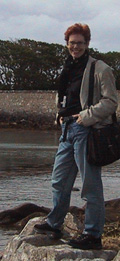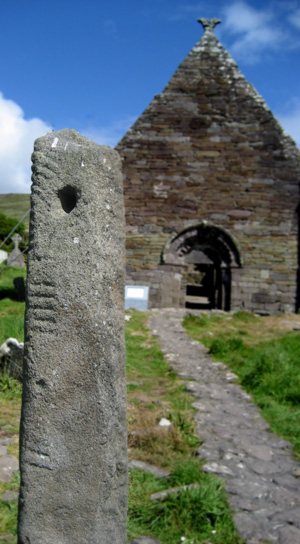
Visit our STORE
 Holy
Trinity!
Holy
Trinity!
When it comes to religion, I'm definitely more of an explorer than a believer. But in Ireland I was up for whatever the ancients had to offer. From the druids to St Patrick, bring it on.
We visited churches and ruined abbeys, walked the Shrule labyrinth, searched for sacred wells and pawed over every ancient Celtic stone we could find. And we jockied for good photo angles with Chinese tourists at the Rock at Cashel, where St Patrick did something or other in the 5th Century.
 It helped to be reading Thomas Cahill ("How the Irish Saved Civilization")
and Timothy Joyce ("Celtic Christianity"). I developed a better appreciation
for the vitality of the early Celtic Christians — before St Augustine
swooped in with his rules and his dark view of human nature and before
the Irish adopted all their post-Famine holier-than Jesus pieties.
It helped to be reading Thomas Cahill ("How the Irish Saved Civilization")
and Timothy Joyce ("Celtic Christianity"). I developed a better appreciation
for the vitality of the early Celtic Christians — before St Augustine
swooped in with his rules and his dark view of human nature and before
the Irish adopted all their post-Famine holier-than Jesus pieties.
But what I don't get is the Trinity. "Father, Son and Holy Ghost" seems like a mysterious remnant from grade school. But the Celts were all over it, so I'm trying to grasp the importance of the concept. Says Fr. Joyce:
We have begun to rediscover the Trinity as central to our faith. Made in the image of God, we find it to be good news to learn that this is a God of relationship, of love, of intimacy, of everlasting sharing, giving, and receiving. That God should be a threefold God was one of the theological and psychological insights of the early church.
The Celts were cool with the concept because they loved abstractions and symbols, were familiar with shape-shifting among their heroes and gods, and thought of everything in threes. The goddess Bridget appeared in three forms, as the goddesses of fire, of poetry, and of fertility.
"Father, Son, and Holy Spirit" is the current Trinity formulation and any adjustments run the risk of heresy, but it seems such an odd trio: 2 guys and a ghost? Son without mother? Maybe Creator, Redeemer, Protector works. I like Transcendant, Incarnate, Immanent — like ice, water, and steam. Out There, Made Man, and Inside Us All. That's definitely a heresy, but when has that stopped me?
Triangles are stable in engineering, but a disaster in relationships. Social workers talk about "triangulating" all the time: one person pitting two others against each other. A child playing his parents. Any three girls who proclaim they are best friends.
But maybe that's the point. In relationships, 3 is dynamic. The energies push and pull. In ecology, it's the disturbance that creates growth and change and overall balance among the flora and fauna. Unity out of diversity.
I like this dynamic-chaotic-creative concept of God. Unfortunately the Catholics drown it in echo-chamber proofs and doctrinal assertions. Bible Christians get shrill. My problem with dogma — too much explaining about how we're right and they're wrong. The Zen practitioners may have the right idea: meditate on the riddle, then write a poem or paint a picture. If the paradox of God as Trinity helps dawn a new era of global consciousness — unity in differences, convergence from divergence — then I'll hang in with St Patrick on the subject.
6.3.07
Thumbs Up if you liked this entry.
NOTES
Photo: Kilmalkedar Church (abt 16th c) with Ogham Stone (5th-6th century), in the church graveyard. Dingle Peninsula, Co Kerry, Ireland. The notches on the stone represent an inscription in the old Irish language of Ogham.
Spirals: Price, 2007